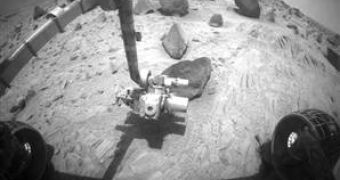If it had been a human being, it would have been more than a thousands years old. It got sand blasted, it lost a limb, multiple instrument functions failed, it got stuck in loose soil, and it is still sprinting for its life. However, this might be Spirit's last drive across the surface of the Red Planet, as the time spent while being trapped in the loose soil could prove to be critical for its power sources.
Spirit and its twin Opportunity, situated on the other side of the planet, have originally been designed to operate only for 90 days on the Martian surface, due to one reason: their operators on Earth were not quite sure if the solar panels could be kept clean for enough time to ensure the power needed to run all the instruments on board. Although struck by a number of sand storms during the four years spent on Mars, the two rovers were able to receive enough power from their solar panels, as they had constantly been cleaned by mild gusts of wind.
However, last summer's sand storm was merciless with Spirit, and covered a big part of its solar panel area with sand. Spirit, unlike its twin, is situated in an area where the wind gusts are not strong enough to sufficiently clean them. So, NASA decided to send it on a slop that would ensure a 25-degree angle, necessary to collect enough electric energy to keep the rover operational. In the middle of November, it got stuck on the Home Plate plateau, in a patch of loose soil, where has it remained for about one week.
NASA's operators started a frantic rescue mission, made even more difficult by the fact that the rover could only drive backwards, since it lost the ability to use its right front wheel nearly two years ago. Though it got unstuck, the rover still had a path which took it over similar treacherous terrain.
Its trip was made even more difficult by the fact that it had to spend a day recharging its batteries in the fading sunlight, for every day of driving, which greatly reduced its chances of reaching the designated spot by the scheduled date of January 1st, next year.
According to NASA, which detailed the rover's situation in the American Geophysical Union meeting, which took place in San Francisco, Spirit is currently operating at 43 percent of its capacity, by using one third of the energy used at the time it was deployed on the Red Planet, and predicts that a further 30 percent drop in the capacity to gather energy as dust accumulation continues.
Unlike Spirit, Opportunity operates at about 70 percent of its capacity, in spite of the fact that it also lost several instruments, and during its first and last Martian winter was only operating at 50 percent capacity. If Spirit is not able to reach the slop in the north of the Home Plate plateau, it will have to remain inactive for most of the winter, in order to conserve energy.
NASA has extended the mission of the two rovers, for a fifth time in October this year since they landed on the Martian surface. Both have been busy with exploring the geology of Mars, Spirit in the general area of the Home Plate, in which it discovered silica rich soil, while Opportunity exposed layers of rock inside a giant crater in the region close to the equator. The silica rich soil found by Spirit represents evidence of hot spring activity, which suggests the existence of a past habitable environment on the surface of Mars.

 14 DAY TRIAL //
14 DAY TRIAL //